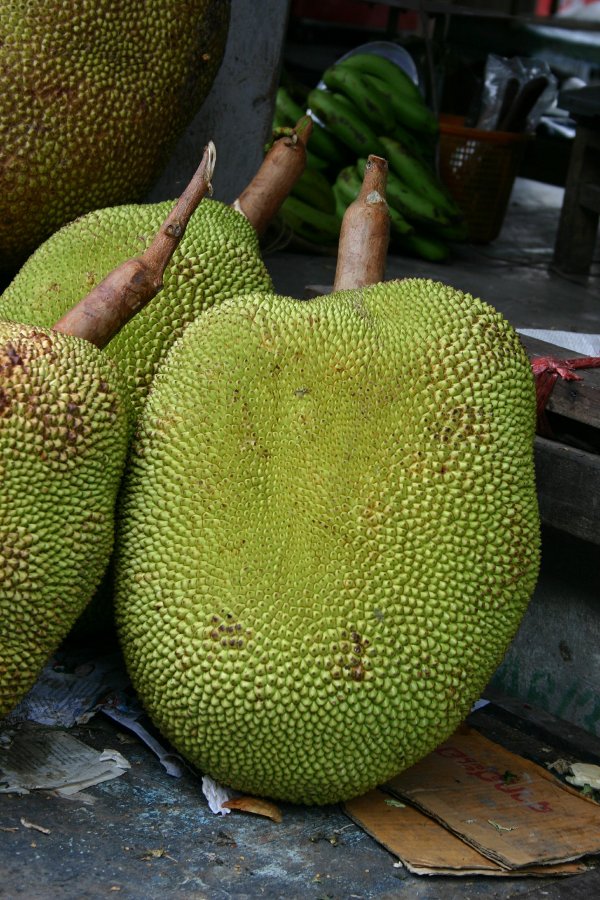Jackfruit

The jackfruit has to be one of my favorite Thai fruits. It has a completely unique taste and texture that is unlike just about any other fruit. It's also definitely high on the list of the world's strangest fruits. You have to keep a sharp eye out for it, as it doesn't make a regular appearance on the street. The best time to find it is around the end of the rainy season in October or November. Although you can find jackfruit in the regular fruit carts when it's at its most plentiful, you're just as likely to find it at other food stalls where the owner may have a special connection to someone who has a tree. If you're looking for it, jackfruit is easy to spot, since the giant pod will take up most of a table top when split open to extract the edible parts.

Jackfruit appears to have originated in western India. It spread through the rest of India and on to South-east Asia. The tree is large and the fruit itself grows not at the tip of limbs but rather out of the trunk. The jackfruit is the largest tree-born fruit in the world. A single pod can reach a length of nearly a meter and weigh close to 40 kilograms. The first place I ever saw a jackfruit tree was within the famous mountain-top temple of Wat Pratat Doi Sutep, just 16 kilometers west of (and more than one kilometer above) Chiang Mai. After climbing the 300 step stairway to the temple from the roadway, one of the first things you'll see is a jackfruit tree growing in the courtyard outside the compound of the gilded pagoda (chedi) that is the symbol of Chiang Mai. If you're lucky, you may see a fruit or two growing out of the trunk.
The outer skin of the fruit is thick and covered with stubby pyramidal bumps. Newcomers sometimes mistake jackfruit for a type of durian, but the bumps on the jackfruit are not sharp like the durian. The skin is light green in color, sometimes shifting to yellow in ripe fruit. If the outside looks a bit odd, the inside of the jackfruit is where things get really strange. The large outer skin is really just a sort of sack, containing as many as 500 seed pods attached to a woody center core. The seeds are quite large, but it's the juicy membrane that surrounds them that is the edible part. The seed sacks are the color of a ripe banana skin, and smell like a mixture of banana and pineapple. The taste is lightly sweet and the texture is fibrous, unlike just about any other fruit. It's a rather tedious job separating the edible part from the rest of the fruit, but vendors can usually sell them almost as fast as they can extract them. Despite all the work, a half dozen pieces will usually cost around 25 U.S. cents.
In its native India, the jackfruit is the subject of a rather infamous letter, supposedly written in 1909, by an irate passenger on the nation's railway. Generally referred to as "the jackfruit letter", it recounts how, having eaten a bit too much jackfruit, the passenger had an urgent need to use the station's facilities. Unfortunately, the guard at the station chose that moment to signal a premature departure of the train from the station, forcing the hapless passenger to rush to re-board the train. In the process he fell down, causing him to, in the words of the letter, "expose my shockings to man, females, woman on platform." The letter supposedly helped to spur the installation of toilets on the Indian trains, although some argue that it's an urban legend.
